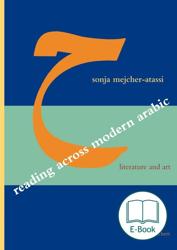Interrelations of literature and art, word and image, are manifold. However, they have remained largely unexplored when it comes to literature and art in the Arab world. This book aims at introducing interarts studies to Middle Eastern studies and, at the same time, hopes to widen the horizon of interarts studies, which represents an interdisciplinary field of research in comparative literature.
The book focuses on three case studies, examining the rapport of Arab writers, Jabra Ibrahim Jabra (1920–1994), Abd al-Rahman Munif (1933–2004) and Etel Adnan (b. 1925), with art, be it as an art critic, an art lover, or an artist in his/her own right. It then sets out to read selected literary texts relationally, across the fields of literature and art, breaking with conventional ways of reading as well as seeing.
Interrelations of literature and art, word and image, are manifold. However, they have remained largely unexplored when it comes to literature and art in the Arab world. This book aims at introducing interarts studies to Middle Eastern studies and, at the same time, hopes to widen the horizon of interarts studies, which has primarily dealt with Western literary and artistic traditions and represents an interdisciplinary field of research in comparative literature.
After methodological considerations and preliminary thoughts on changing notions of literature and art in the modern Arab world, the book focuses on three case studies, examining the rapport of Arab writers with art, be it as an art critic, an art lover, or an artist in his/her own right. It in particular looks at Jabra Ibrahim Jabra, Abd al-Rahman Munif and Etel Adnan who contributed profoundly to modern Arabic literature in the second half of the twentieth century. In correspondence with their life trajectories – spanning the Arab world from Bethlehem to Jerusalem, Baghdad, Amman, Beirut, Cairo, and Damascus, and beyond the Arab world from Cambridge to London, Belgrade, Paris, and California – it does not focus on one country but gives testimony to the transnational as well as transcultural character of cultural production in the Arab world. It then sets out to read selected literary texts relationally, across the fields of literature and art, breaking with conventional ways of reading and seeing.
In reading across modern Arabic literature and art the book sets out to study artistic practices, be they word or image oriented, in context and thus contributes to a better understanding of modern Arabic literature and art beyond the confines of the single disciplines. Its interdisciplinary approach opens new perspectives on modern Arabic literature and art alike. The book is addressed at scholars and students in Middle Eastern studies, comparative literature, art history, and cultural history, as well as at a general public interested in literature and art beyond the Western canon.
Dr. Sonja Mejcher-Atassi is Assistant Professor in the Civilization Sequence Program at the American University of Beirut. She studied Oriental Studies at Oxford University (DPhil 2005) and Comparative Literature and Arabic Studies at the Free University of Berlin (MA 2000). Her research interests are in modern and contemporary literature and art in the Arab world, interrelations of word and image, politics and art, book art, collection and museum studies, gender studies, cultural memory and history.
Her publications include: “Reading across Modern Arabic Literature and Art” (Wiesbaden: Reichert, Literaturen im Kontext 34, 2012); (ed. together with John Pedro Schwartz), “Museums, Archives and Collecting Practices in the Modern Arab World” (Farnham: Ashgate, 2012); “Contemporary Book Art in the Middle East: The Book as Document in Iraq,” in: Art History 35/5 (2012); “On the Necessity of Writing the Present. Elias Khoury and ‘the Birth of the Novel’ in Lebanon,” in: Angelika Neuwirth, Andreas Pflitsch and Barbara Winckler (eds.), “Arabic Literature. Postmodern Perspectives” (London: Saqi, 2010), reprinted in: “Twentieth Century Literary Criticism” (Gale/Cengage Learning, vol. 262, 2012); “The Forbidden Paradise. How Etel Adnan Learned to Paint in Arabic,” in: Angelika Neuwirth, Andreas Pflitsch and Barbara Winckler (eds.), “Arabic Literature. Postmodern Perspectives ” (London: Saqi, 2010); (ed.), “Writing a ‘Tool for Change’: ‘Abd al-Rahman Munif Remembered,” in: MIT Electronic Journal of Middle East Studies 7 (2007); “Geschichten über Geschichten: Erinnerung im Romanwerk von Elias Khoury” (Wiesbaden: Reichert, Literaturen im Kontext 8, 2001).
Diese Reihe stellt innovative Arbeiten zu den nahöstlichen Literaturen in ihren verschiedenen Epochen und Gattungen vor. Sie versteht sich nicht ausschließlich als ein Forum für Orientwissenschaftler, sondern möchte auch Komparatisten, Literaturwissenschaftlern und einer interessierten Öffentlichkeit Einblicke in das breite Spektrum gegenwärtig produzierter und rezipierter Literatur des Nahen Ostens bieten.
Denn die Herausgeberinnen, Autorinnen und Autoren wollen den Titel der Reihe programmatisch verstanden wissen. Sie gehen von einem Begriff der Weltliteratur aus, der die orientalischen Literaturen nicht nur statisch einbegreift, sondern sie in ein Kulturregionen und Nationalsprachen übergreifendes Spannungsfeld stellt, dessen Dynamik erst im interdisziplinären Austausch erfasst werden kann. Sie gehen ferner davon aus, dass Literaturen in vielfacher Weise intertextuell geprägt sind, dass sie Lektüren verschiedenster vorausgehender Texte darstellen und daher erst in ihrem „lokalen historischen Kontext“ ihren Reiz als Ausdruck einer regional geprägten Ästhetik entfalten können. Die Reihe versucht so, einer neuen Sensibilität für mythische, archetypische, aber auch historische Subtexte in der nahöstlichen Literatur Bahn zu brechen, sie aber gleichzeitig als wichtigen Ausdruck einer globalen kulturellen Mobilität sichtbar zu machen.


 Vorwort
Vorwort